General, Sir John Monash, Personal Files Book 20, 15 August - 8 September 1918 - Part 10
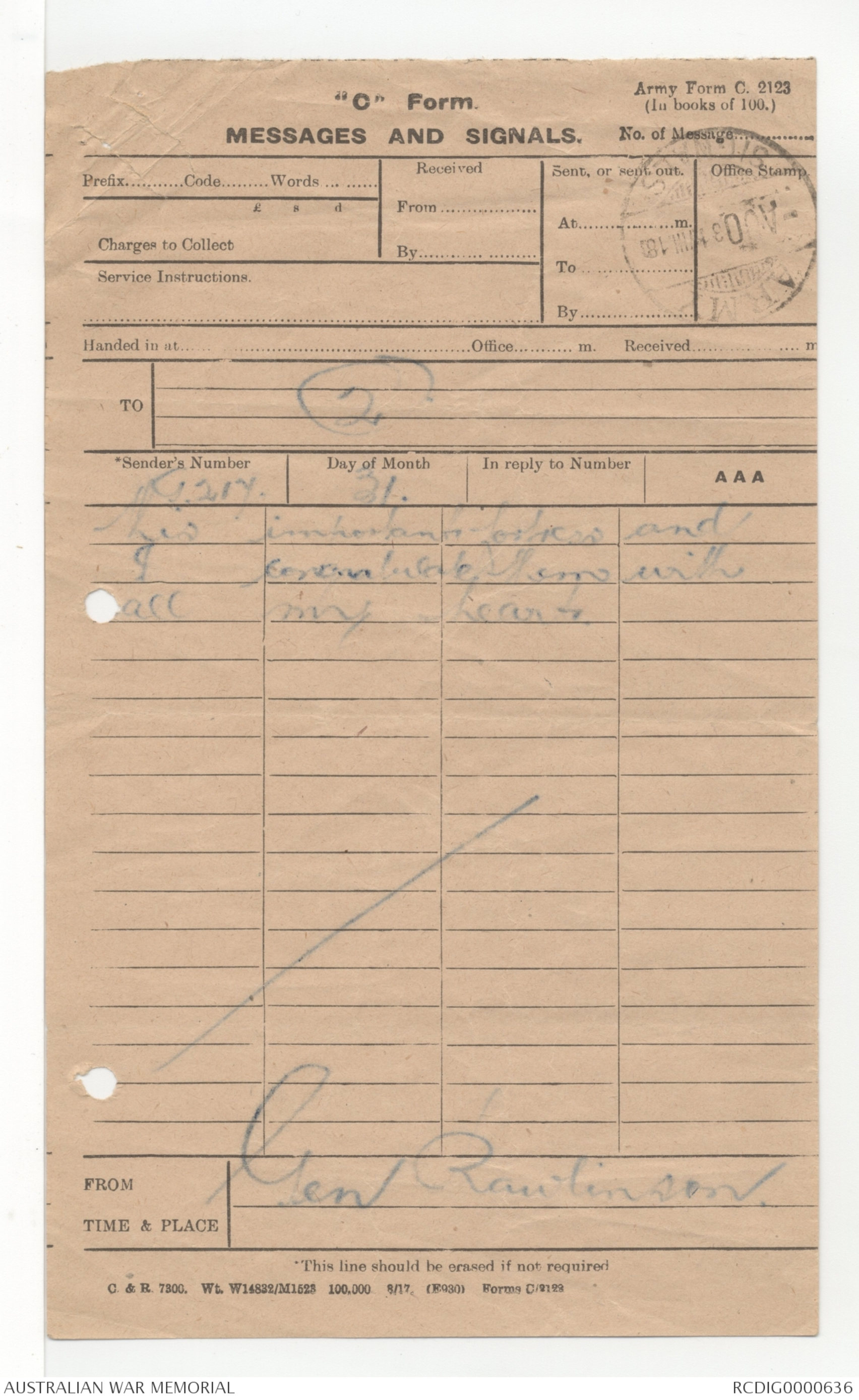
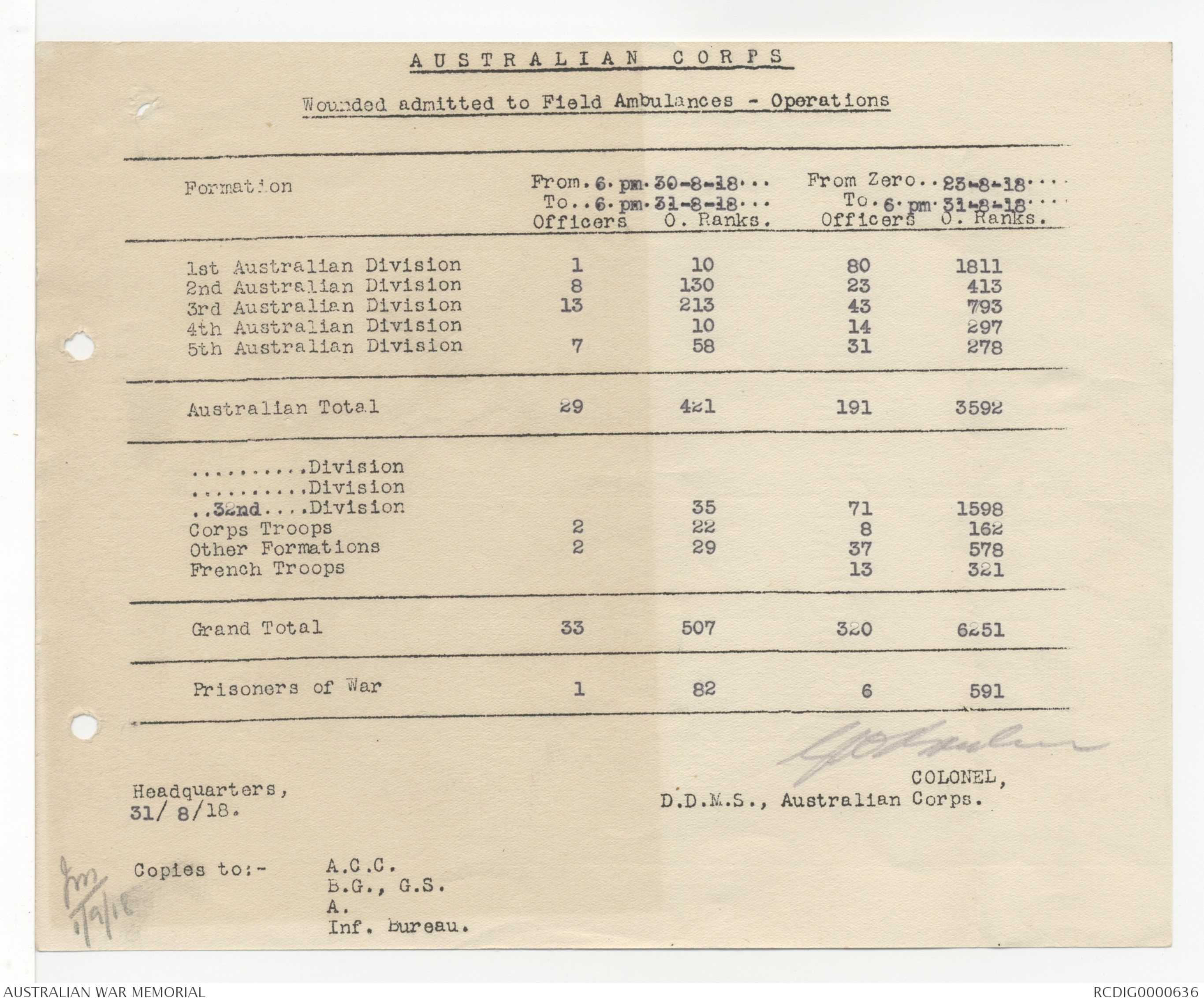
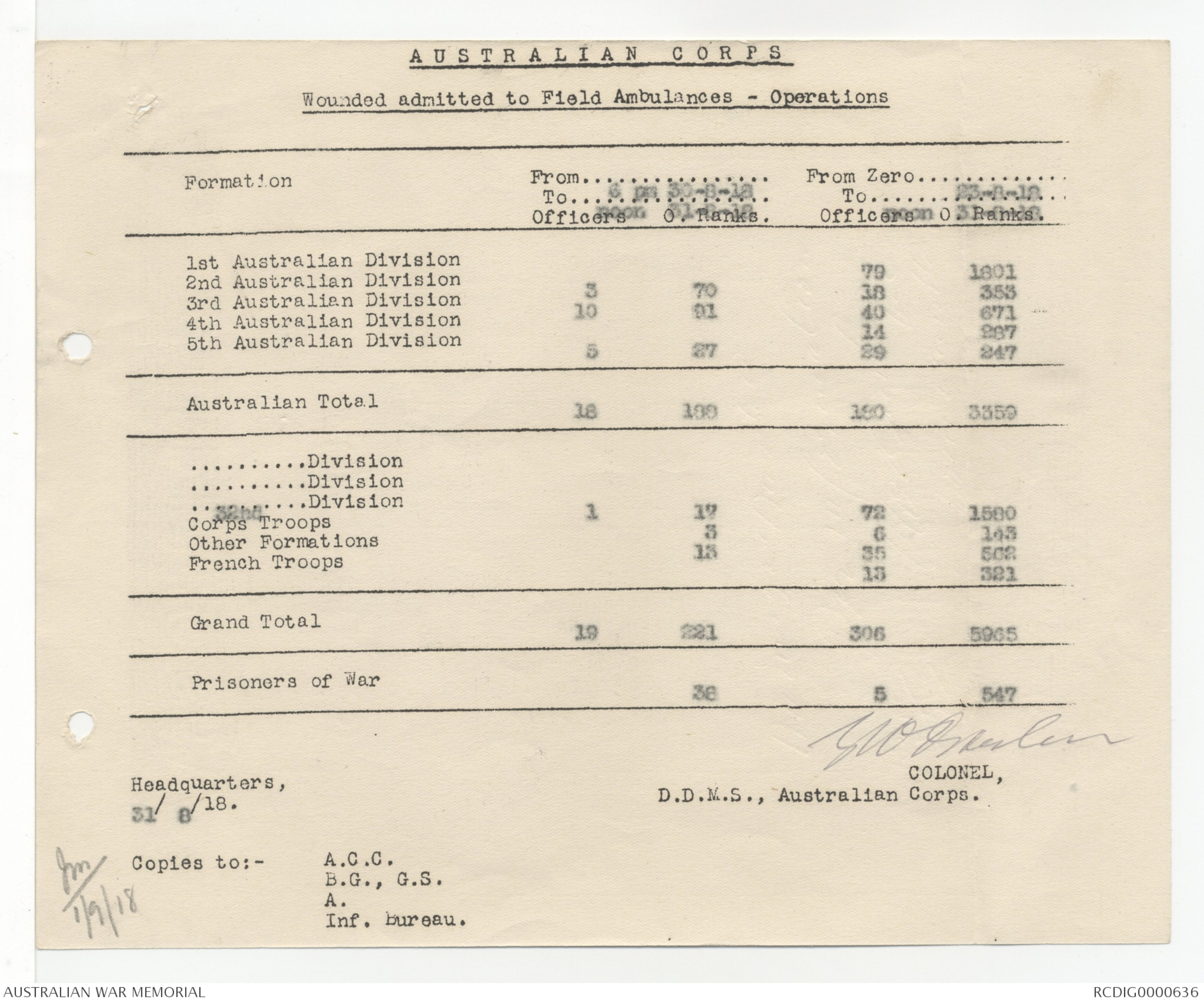
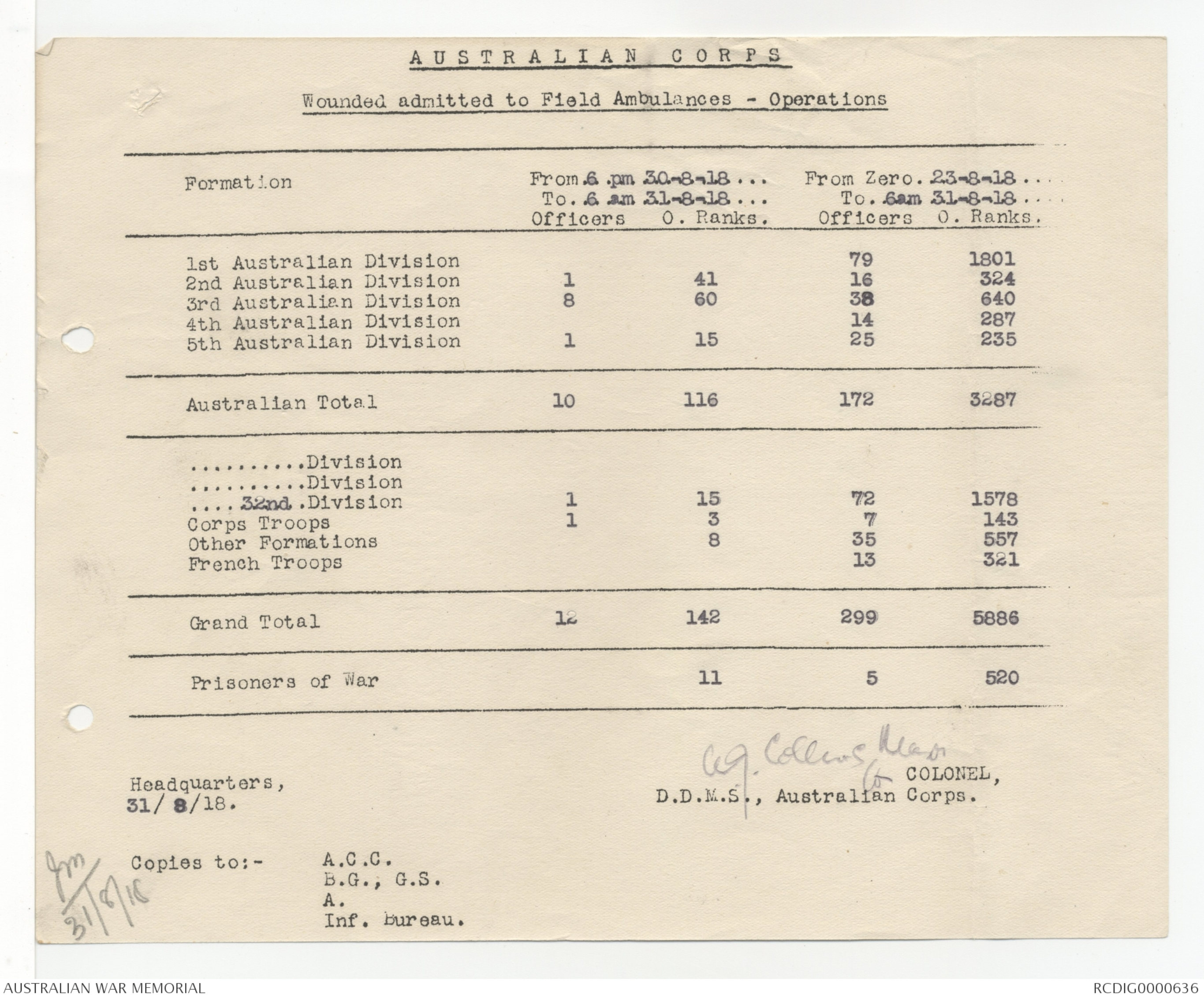
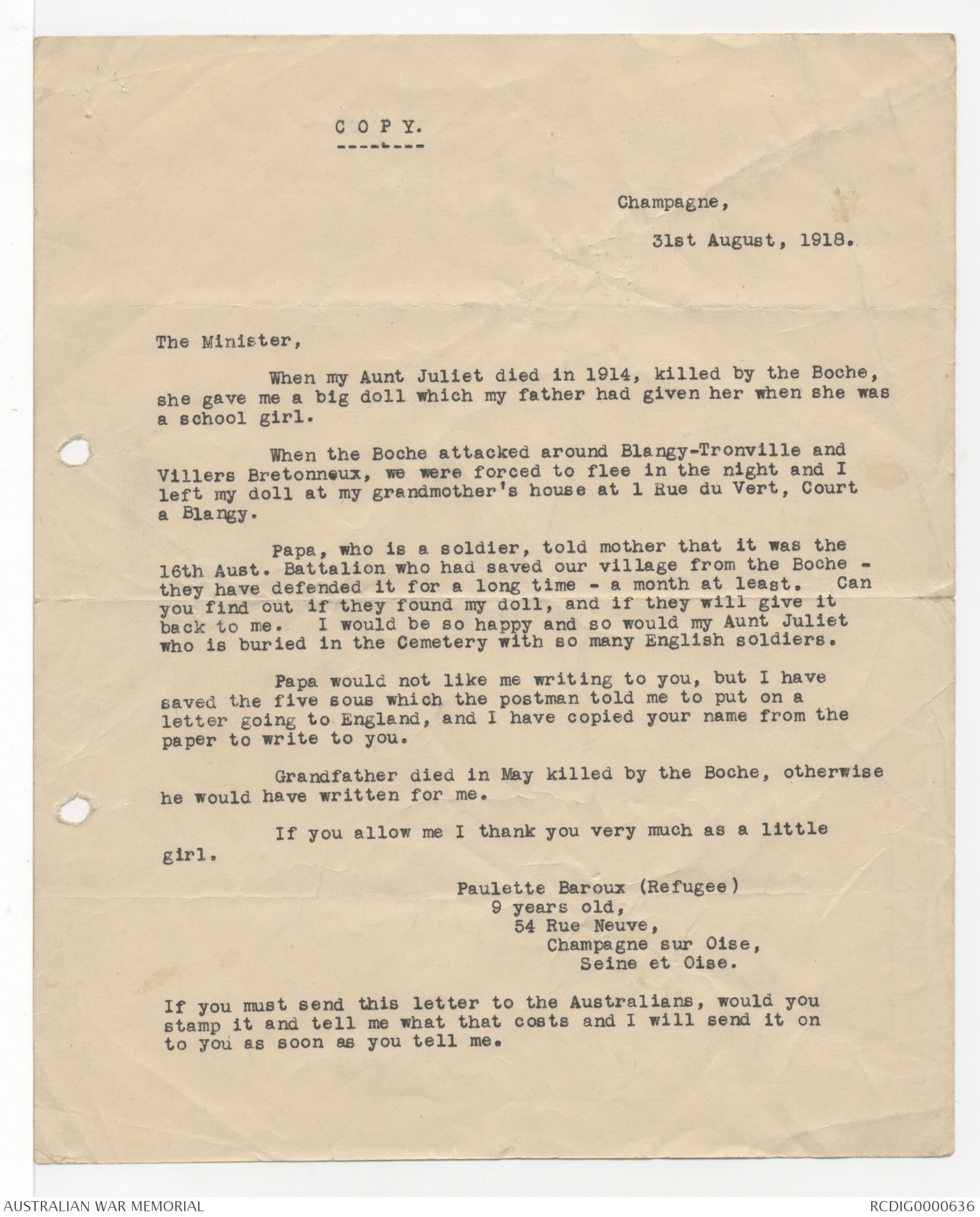
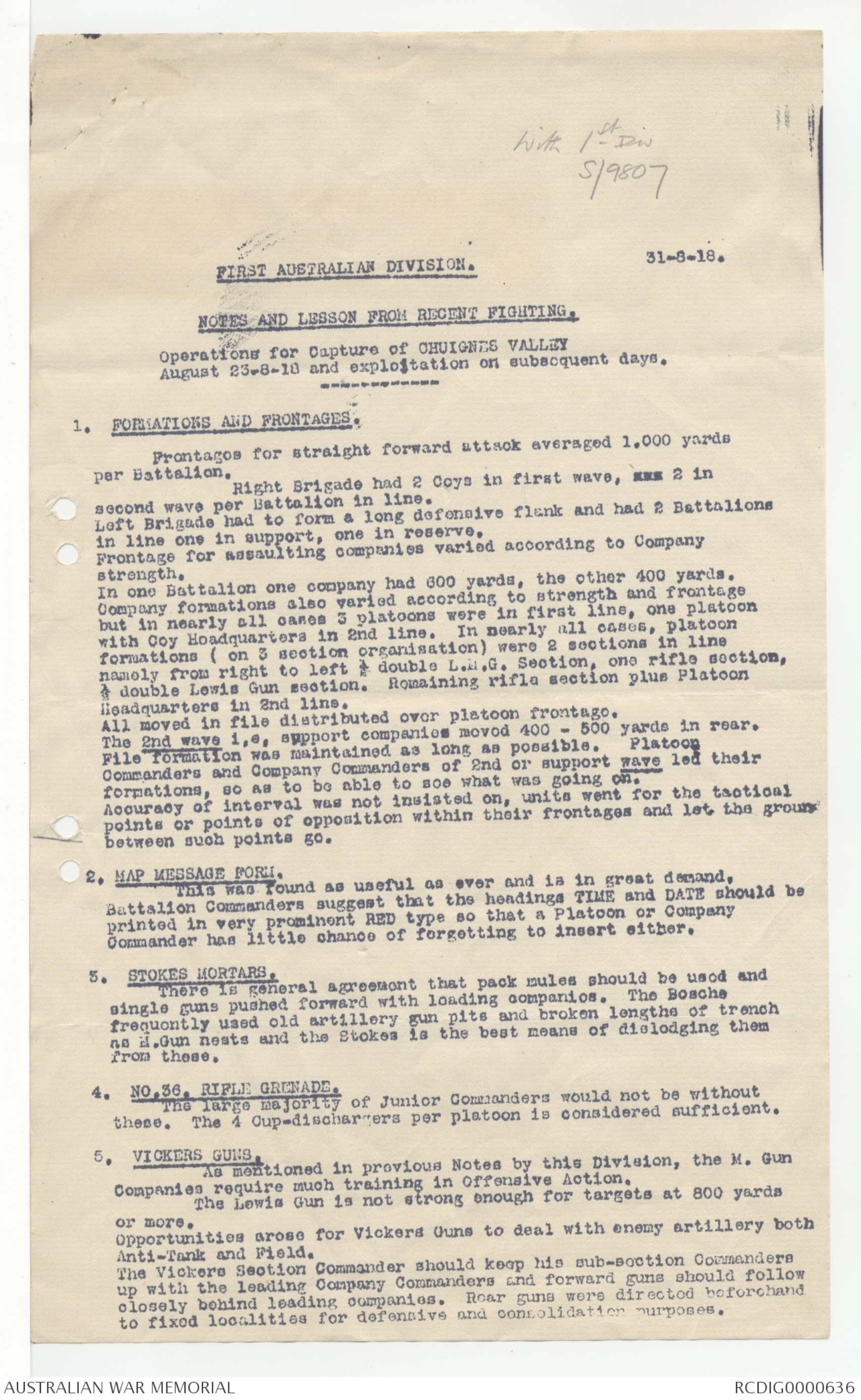
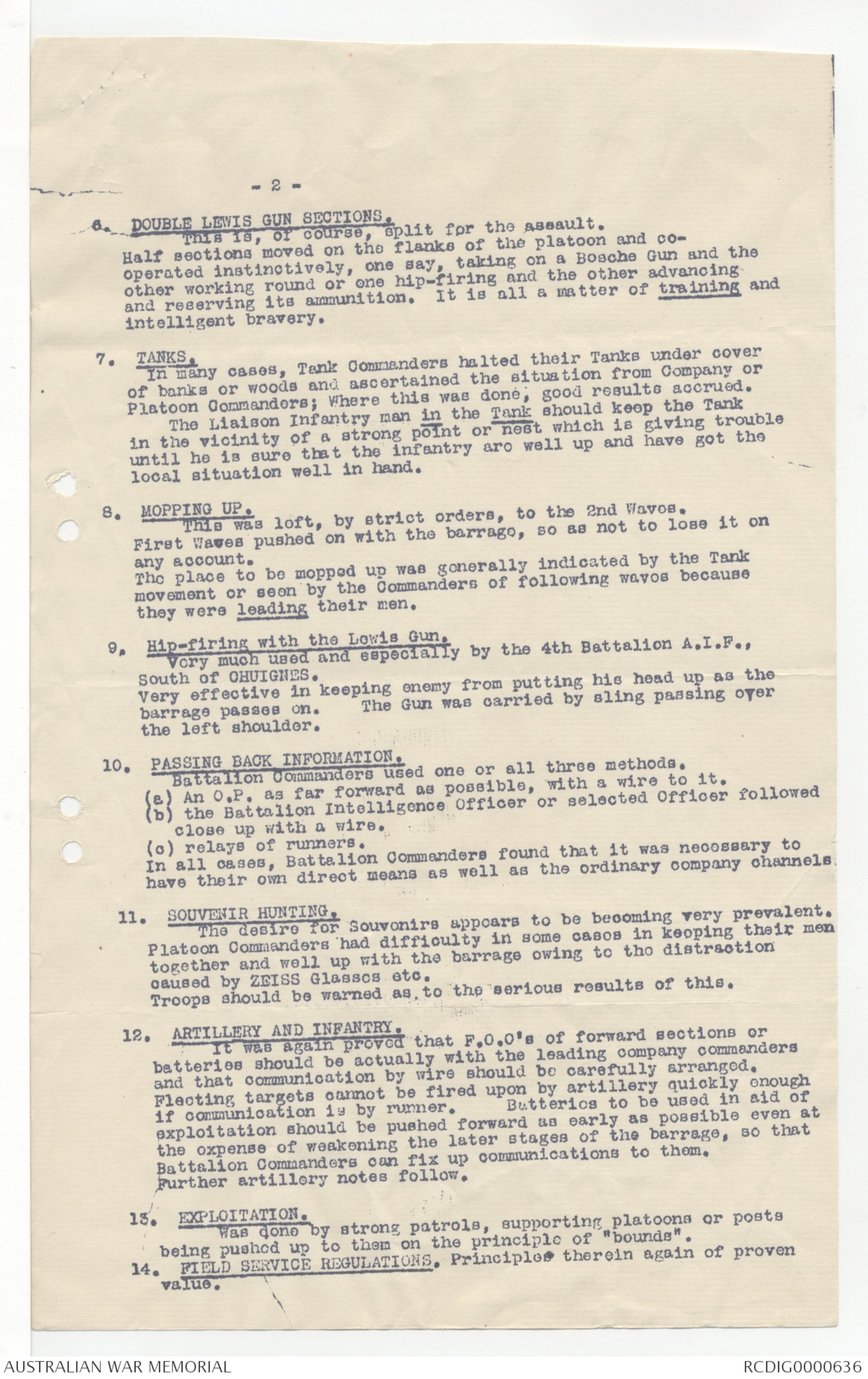
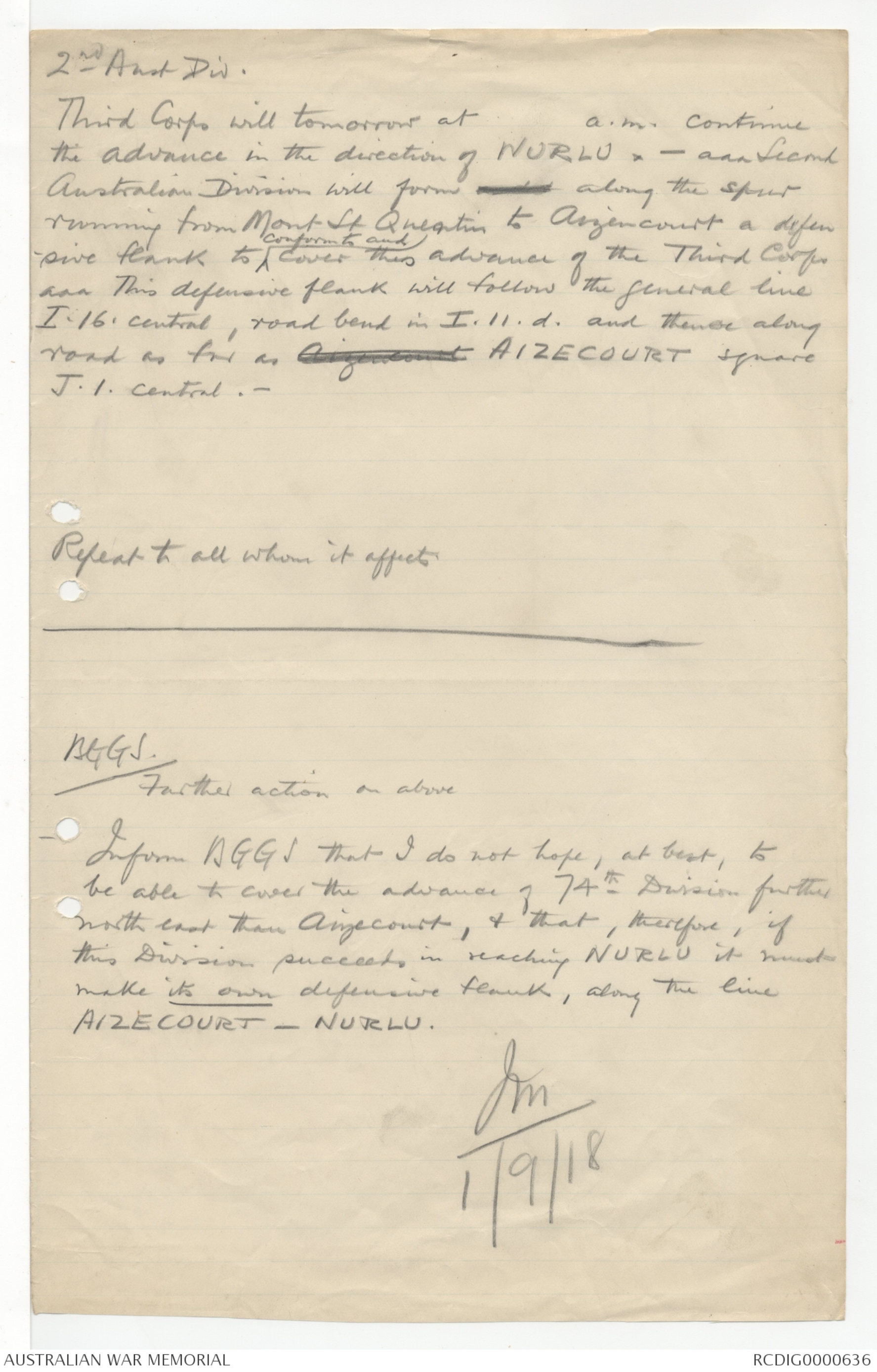
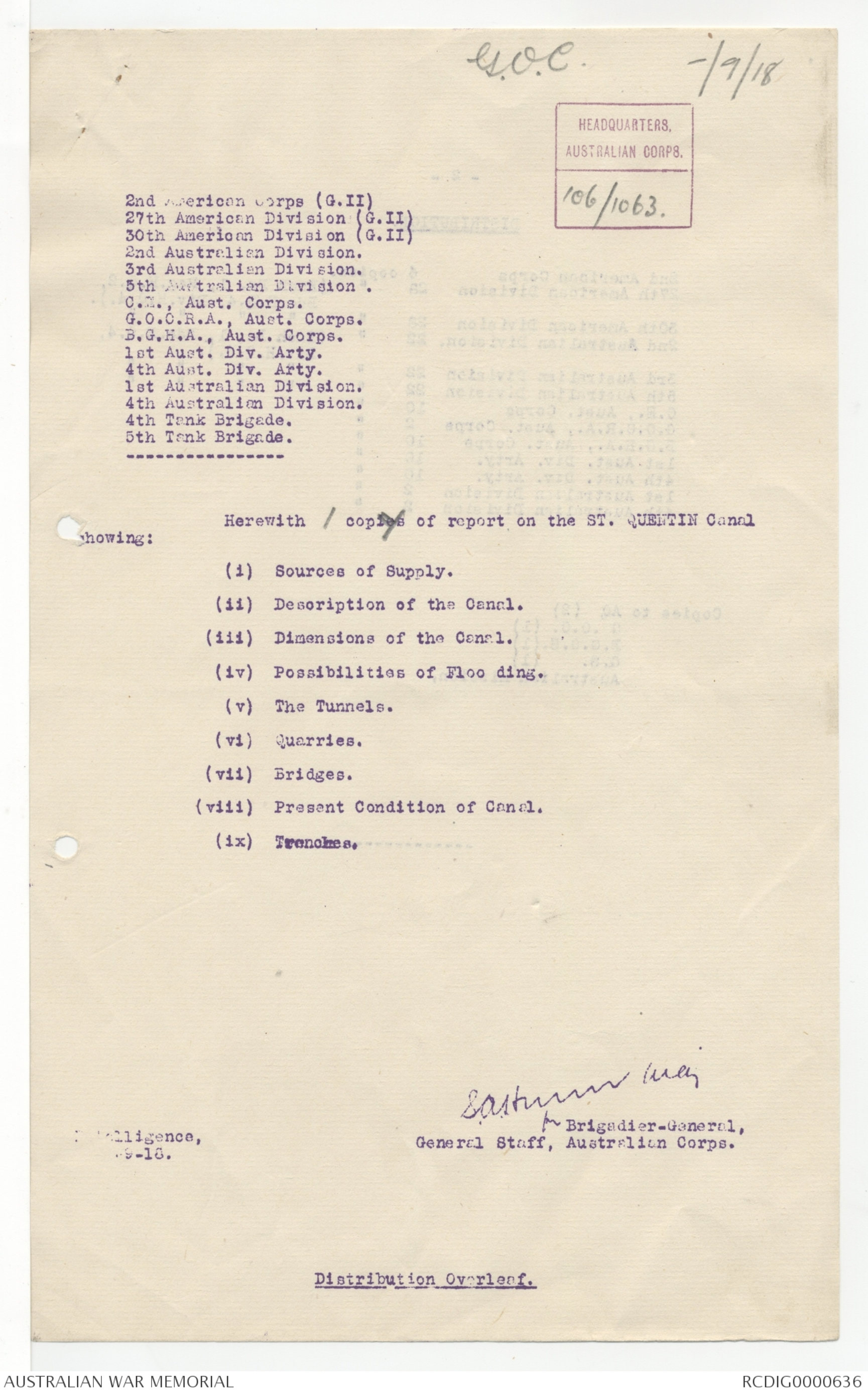
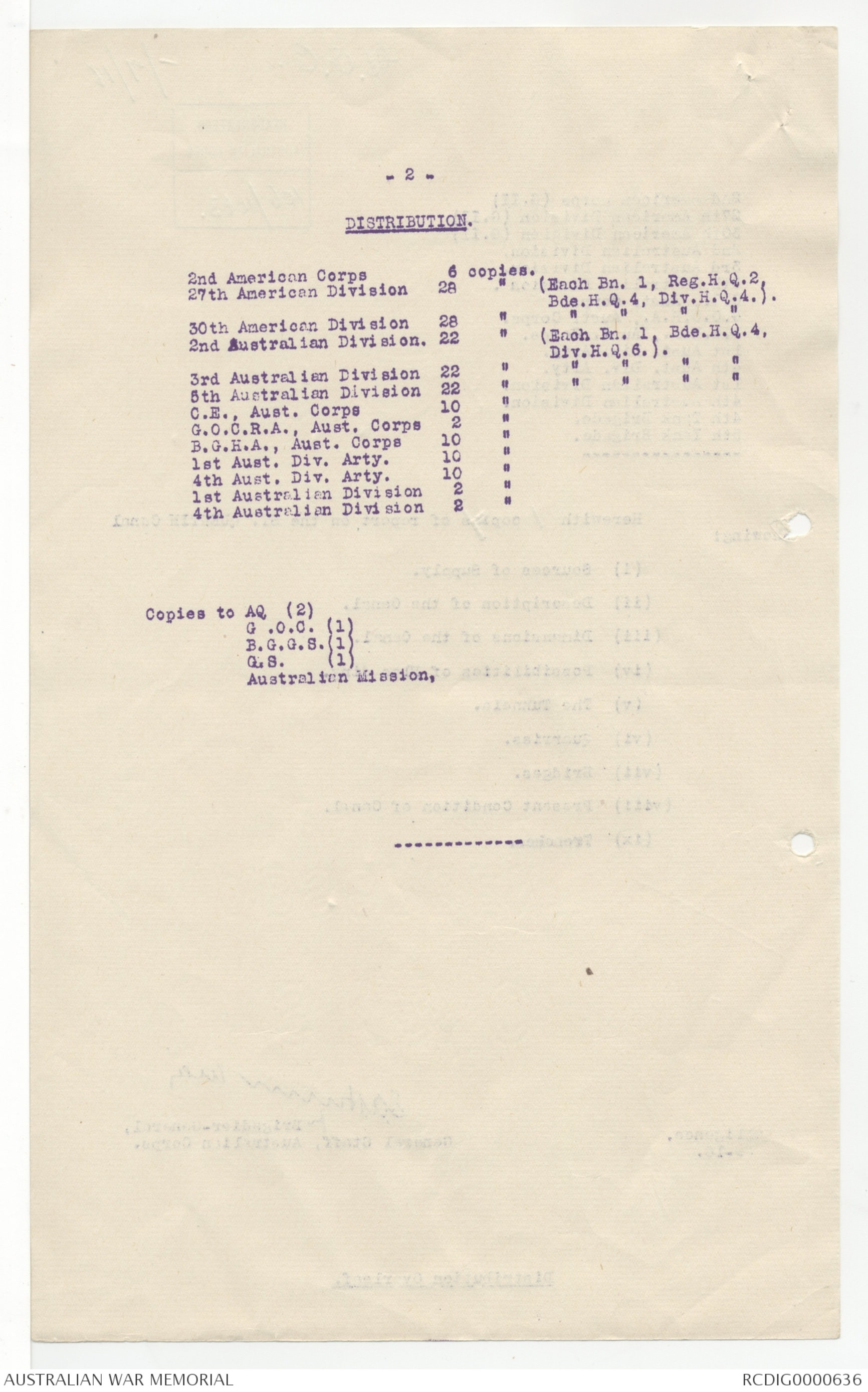
"C" Form
MESSAGES AND SIGNALS
[*
T0 ➁
*Sender's Number K1217.
Day of Month 31.
TIME & PLACE
AAA
This important [[?]] and
I congratulate Troops with
all my heart
FROM Gen Rawlinson.
TIME & PLACE
AUSTRALIAN CORPS
Wounded admitted to Field Ambulances - Operations
| Formation |
From 6 pm 30-8-18 |
From Zero 23-8-18 |
||
|
Officers |
O. Ranks. |
Officers |
O. Ranks. |
|
| 1st Australian Division |
1 |
10 |
80 |
1811 |
| 2nd Australian Division |
8 |
130 |
23 |
413 |
| 3rd Australian Division |
13 |
213 |
43 |
793 |
| 4th Australian Division |
|
10 |
14 |
297 |
| 5th Australian Division |
7 |
58 |
31 |
278 |
| Australian Total |
29 |
421 |
191 |
3592 |
| . . . . . Division |
|
|
|
|
| . . . . . Division |
|
|
|
|
| 32nd Division |
|
35 |
71 |
1598 |
| Corps Troops |
2 |
22 |
8 |
162 |
| Other Formations |
2 |
29 |
37 |
578 |
| French Troops |
|
|
13 |
321 |
| Grand Total |
33 |
507 |
320 |
6251 |
| Prisoners of War |
1 |
82 |
6 |
591 |
[[?]]
COLONEL,
D.D.M.S., Australian Corps.
Headquarters,
31/8/18.
Copies to:- A.C.C.
B.G., G.S.
A.
Inf. Bureau.
[*JM
1/9/18*]
AUSTRALIAN CORPS
Wounded admitted to Field Ambulances - Operations
| Formation |
From noon 31-8-18 |
From Zero 23-8-18 |
||
|
Officers |
O. Ranks. |
Officers |
O. Ranks. |
|
| 1st Australian Division |
|
|
|
|
| 2nd Australian Division |
|
|
79 |
1801 |
| 3rd Australian Division |
3 |
70 |
18 |
353 |
| 4th Australian Division |
10 |
91 |
40 |
671 |
| 5th Australian Division |
|
|
14 |
287 |
|
5 |
27 |
29 |
247 |
|
| Australian Total |
18 |
188 |
180 |
3359 |
| . . . . . Division |
|
|
|
|
| . . . . . Division |
|
|
|
|
| 32nd Division |
1 |
17 |
72 |
1580 |
| Corps Troops |
|
3 |
6 |
163 |
| Other Formations |
|
13 |
35 |
502 |
| French Troops |
|
|
13 |
321 |
| Grand Total |
19 |
221 |
306 |
5965 |
| Prisoners of War |
|
38 |
5 |
547 |
[[?]]
COLONEL,
D.D.M.S., Australian Corps.
Headquarters,
31/8/18.
Copies to:- A.C.C.
B.G., G.S.
A.
Inf. Bureau.
[*JM
1/9/18*]
AUSTRALIAN CORPS
Wounded admitted to Field Ambulances - Operations
| Formation |
From 6 pm 30-8-18 |
From Zero 23-8-18 |
||
|
Officers |
O. Ranks. |
Officers |
O. Ranks. |
|
| 1st Australian Division |
|
|
79 |
1801 |
| 2nd Australian Division |
1 |
41 |
16 |
324 |
| 3rd Australian Division |
8 |
60 |
38 |
640 |
| 4th Australian Division |
|
|
14 |
287 |
| 5th Australian Division |
1 |
15 |
25 |
235 |
| Australian Total |
10 |
116 |
172 |
3287 |
| . . . . . Division |
|
|
|
|
| . . . . . Division |
|
|
|
|
| 32nd Division |
1 |
15 |
72 |
1578 |
| Corps Troops |
1 |
3 |
7 |
143 |
| Other Formations |
|
8 |
35 |
557 |
| French Troops |
|
|
13 |
321 |
| Grand Total |
12 |
142 |
299 |
5886 |
| Prisoners of War |
|
11 |
5 |
520 |
A G. Collins Major
for COLONEL,
D.D.M.S., Australian Corps.
Headquarters,
31/8/18.
Copies to:- A.C.C.
B.G., G.S.
A.
Inf. Bureau.
[*JM
31/8/18*]
COPY.
Champagne,
31st August, 1918.
The Minister,
When my Aunt Juliet died in 1914, killed by the Boche,
she gave me a big doll which my father had given her when she was
a school girl.
When the Boche attacked around Blangy-Tronville and
Villers Bretonnoux, we were forced to flee in the night and I
left my doll at my grandmother's house at 1 Rue du Vert, Court
a Blangy.
Papa, who is a soldier, told mother that it was the
16th Aust. Battalion who had saved our village from the Boche -
they have defended it for a long time - a month at least. Can
you find out if they found my doll, and if they will give it
back to me. I would be so happy and so would my Aunt Juliet
who is buried in the Cemetery with so many English soldiers.
Papa would not like me writing to you, but I have
saved the five sous which the postman told me to put on a
letter going to England, and I have copied your name from the
paper to write to you.
Grandfather died in May killed by the Boche, otherwise
he would have written for me.
If you allow me I thank you very much as a little
girl.
Paulette Baroux (Refugee)
9 years old,
54 Rue Neuve,
Champagne sur Oise,
Seine et Oise.
If you must send this letter to the Australians, would you
stamp it and tell me what that costs and I will send it on
to you as soon as you tell me.
[* With 1st Div
S/9807*]
FIRST AUSTRALIAN DIVISION.
31-8-18.
NOTES AND LESSON FRON RECENT FIGHTING.
Operations for Capture of CHUIGNES VALLEY
August 23-8-18 and exploitation on susequent days.
1. FORMATIONS AND FRONTAGES.
Frontages for straight forward attack averaged 1.000 yards
per Battalion,
Right Brigade had 2 Coys in first wave, and 2 in
second wave per Battalion in line.
Left Brigade had to form e long defensive flank and had 2 Battalions
in line one in support, one in reserve.
Frontage for assaulting companies varied according to Company
strength.
In one Battalion one company had 600 yards, the other 400 yards.
Company formations also varied according to strength and frontage
but in nearly all oases 3 platoons were in first line, one platoon
with Coy Headquarters in 2nd line. In nearly all cases, platoon
formations (on 3 section organisation) were 2 sections in line
namely from right to left ½ double L.H.G. Section, one rifle section,
½ double Lewis Gun section. Remaining rifle section plus Platoon
Headquarters in 2nd line.
All moved in file distributed over platoon frontage.
The 2nd wave i,e, support companies moved 400 - 500 yards in rear.
File formation was maintained as long as possible. Platoon
Commanders and Company Commanders of 2nd or support wave led their
formations, so as to be able to see what was going on.
Accuracy of interval was not insisted on, units went for the tactical
points or points of opposition within their frontages and let the grouns
between such points go.
2. MAP MESSAGE FORM.
This was found as useful as ever and is in great demand,
Battalion Commanders suggest that the headings TIME and DATE should be
printed in very prominent RED type so that a Platoon or Company;
Commander has little chance of forgetting to insert either.
3. STOKES MORTARS.
There Is general agreement that pack mules should be used and
single guns pushed forward with loading companies. The Bosche
frequently used old artillery gun pits and broken lengths of trench
as M.Gun nests and the Stokes is the best means of dislodging them
from these.
4. N0.36. RIPLE GRENADE.
The large majority of Junior Commanders would not be without
these. The 4 Cup-dischargers per platoon is considered sufficient.
5. VICKERS GUNS.
As mentioned in previous Notes by the Division, the M. Gun
Companies require much training in Offensive Action,
The Lewis Gun is not strong enough for targets at 800 yards
or more.
Opportunities arose for Vickers Guns to deal with enemy artillery both
Anti-Tank and Field.
The Vickers Section Commander should keep his sub-section Commanders
up with the leading Company Commanders and forward guns should follow
closely behind leading companies. Rear guns were directed beforehand
to fixed localities for defensive and consolidation purposes.
-2 -
6. DOUBLE LEWIS GUN SECTIONS.
This is, of course, split for the assault.
Half sections moved on the flanks of the platoon and cooperated
instinctively, one say, taking on a Bosche Gun and the
other working round or one hip-firing and the other advancing
and reserving its ammunition. It is all a matter of training and
intelligent bravery.
7. TANKS.
In many cases, Tank Commanders halted their Tanks under cover
of banks or woods and ascertained the situation from Company or
Platoon Commanders; Where this was done, good results accrued.
The Liaison Infantry man in the Tank should keep the Tank
in the vicinity of a strong point or nest which is giving trouble
until he is sure that the infantry are well up and have got the
local situation well in hand.
8. MOPPING UP.
This was left, by strict orders, to the 2nd Waves.
First Wacves pushed on with the barrage, so as not to lose it on
any account.
The place to be mopped up was generally indicated by the Tank
movement or seen by the Commanders of following waves because
they were leading their men.
9. Hip-firing with the Lowis Gun.
Very much used and especially by the 4th Battalion A.I.F.,
South of CHUIGNES.
Very effective in keeping enemy from putting his head up as the
barrage passes on. The Gun was carried by sling passing over
the left shoulder.
10. PASSING BACK INFORMATION.
Battalion Commanders used one or all three methods.
(a) An O.P. as far forward as possible, with a wire to it.
(b) the Battalion Intelligence Officer or selected Officer followed
close up with a wire.
(c) relays of runners.
In all cases, Battalion Commanders found that it was necessary to
have their own direct means as well as the ordinary company channels
11. SOUVENIR HUNTING.
The desire for Souvenirs appears to be becoming very prevalent.
Platoon Commanders had difficulty in some cases in keeping their men
together and well up with the barrage owing to the distraction
caused by ZEISS Glasses etc.
Troops should be warned as to the serious results of this.
12. ARTILLERY AND INFANTRY.
It was again proved that F.O.O's of forward sections or
batteries should be actually with the leading company commanders
and that communication by wire should be carefully arranged.
Fleeting targets cannot be fired upon by artillery quickly enough
if communication is by runner, Batteries to be used in aid of
exploitation should be pushed forward as early as possible even at
the expense of weakening the later stages of the barrage, so that
Battalion Commanders can fix up communications to them.
Further artillery notes follow.
13. EXPLOITATION.
Was done by strong patrols, supporting platoons or posts
being pushed up to them on the principle of "bounds".
14. FIELD SERVICE REGULATIONS. Principles therein again of proven
value.
2nd Aust Div.
Third Corps will tomarrow at a.m. continue
the advance in the direction of NURLE x – aaa Second
Australian Division will form [[?ded]] along the spur
running from Mont St Quentin to Aizecourt a defensive
flank to ^conform to and cover this advance of the Third Corps
aaa This defensive flank will follow the general line
I.16.central, road bend in I.11.d and thence along
road as far as Aizecourt AIZECOURT square
J.1.central,-
repeat to all whom it affects
BGGS.
Further action on above
Inform BGGS that I do not hope, at best, to
be able to cover the advance of 74th Division further
north east the Aizecourt, & that, therefore, if
this Division succeeds in reaching NURLU it must
make its own defensive flank, along the line
AIZECOURT - NURLU,
JM
1/9/18
[* G.O.C.
-/9/18*]
[*HEADQUARTERS
AUSTRALIAN CORPS
106/1063.*]
2nd American Corps (G.II)
27th American Division (G.II)
30th American Division (G.II)
2nd Australian Division.
3rd Australian Division.
5th Australian Division.
C.M., Aust. Corps.
G.O.C.R.A., Aust. Corps.
B.G.H.A., Aust. Corps.
1st Aust. Div. Arty.
4th Aust. Div. Arty.
1st Australian Division.
4th Australian Division.
4th Tank Brigade.
5th Tank Brigade.
Herewith / copiesy of report on the ST. QUENTIN Canal
showing:
(i) Sources of Supply.
(ii) Description of the Canal.
(iii) Dimensions of the Canal.
(iv) Possibilities of Floo ding.
(v) The Tunnels.
(vi) Quarries.
(vii) Bridges.
(viii) Present Condition of Canal.
(ix) Trenches.
Sueses une
for Brigadier-General,
General Staff, Australian Corps.
Intelligence,
[[?]]9-18.
Distribution Overleaf.
- 2 -
Distribution,
2nd American Corps 6 copies.
27th American Division 28 " (Each Bn. 1, Reg.H.Q.2,
Bde.H.Q.4, Div.H.Q.4.).
30th American Division 28 " " " " ""
2nd Australian Division 22 " (Each Bn. 1, Bde.H.Q.4,
Div.H.Q.6.).
3rd Australian Division 22 " " " " "
5th Australian Division 22 " " " " "
C.E., Aust. Corps 10 "
G.O.C.R.A., Aust. Corps 2 "
B.G.H.A., Aust. Corps 10 "
1st Aust. Div. Arty. 10 "
4th Aust. Div. Arty. 10 "
1st Australian Division 2 "
4th Australian Division 2 "
Copies to Ag (2)
G.0.C. (1)
B.G.G.S.(1)
G.S. (1)
Australian Mission,
 Sam scott
Sam scottThis transcription item is now locked to you for editing. To release the lock either Save your changes or Cancel.
This lock will be automatically released after 60 minutes of inactivity.